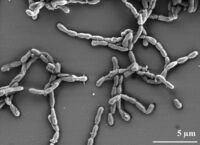Dyadobacter fermentans
Classification
Higher order taxa
Bacteria; Bacteroidota; Cytophagia; Cytophagales; Spirosomaceae
Species
Dyadobacter fermentans
The Dyadobacter Genus currently consists of 14 recognized species. They have been isolated from various environments such as freshwater, seawater, glaciers, desert sand, plants, soils, and animals. Its 16s rRNA gene sequence has less than 88% similarity to any other bacterial genus.
Description and Significance
Dyadobacter fermentans is a Biosafety level 1 organism. It is aerobic, heterotrophic, and non-motile. It produces a pigment similar to flexirubin.
It can survive in nitrogen limited conditions by competing with the host plant for resources.
It was discovered by Marisa K. Chelius and Eric W. Triplet in 2000Isolated and discovered in 2000, Dyadobacter fermentans is an aerobic, gram-negative, non-motile, rod shaped chemoorganotroph. The rods can appear as pairs or in chains. D. fermentans is found in many plants, the cysts of nematodes (Heterodera glycines), and in contaminated soil. This strain can also be isolated from the stem of maize plants when watered with fertilizer containing no nitrogen. The term “fermentans” is derived from the bacterium's ability to ferment glucose and fructose.
D. fermentans can decrease N2O emissions in soil, allowing it to be utilized as a bacterial form of denitrification in the rhizosphere. This ability has potential for various environmental applications, which could mitigate greenhouse gasses from agricultural fields.
Genome Structure
Dyadobacter fermentans has a genome that is 6,967,790 bp long that consists of one main circular chromosome. The chromosome has a 51.4% GC content. It has 5,854 predicted genes. Of the 5,854 genes, 5,804 genes were protein-coding and 50 were RNA-coding. 64.7% of the protein-coding genes are thought to have a putative function, while the remaining protein-coding genes are designated as hypotehical. 85 pseudogenes have also been identified in the D. fermentans genome.
Cell Structure, Metabolism and Life Cycle
This bacterium’s carbon source is from carbohydrates, but not polymers. Its energy source is glucose and sucrose via fermentation. D. fermentans is composed of unsaturated and saturated iso-branched species, straight chain unsaturated species, as well as iso-branched, hydroxylated species. The cells of D. fermentans are composed of polyamine and putrescine as major components and cadaverine and spermine as minor compents.
Ecology and Pathogenesis
Maize (Zea mays) a is host to Dyadobacter fermentans, where it dwells in the roots of the plant. The presence or lack of D. fermentans has no significant influence over yield in Maize plants. Consequently, D. fermentans is thought to be neither beneficial nor pathogenic to Maize.

